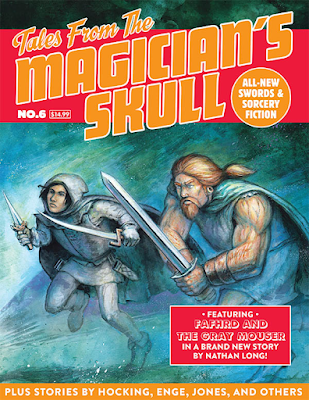 |
| More witches! Art by Jones. |
Anyway, I got to reading these old back issues and that led me where my reading inevitably does—to thinking, and writing. I sent a lengthy article about S&S in Fantastic, including the four L. Sprague de Camp/Lin Carter Conan pastiches that appeared between 1972-75, over to Dave Ritzlin at DMR Books the other day. I expect that to appear on his website next week.
Speaking of pastiches, I recently started reading The Goddess of Ganymede (excellent thus far) and author Michael D. Resnick leads off the volume with this:
To Edgar Rice Burroughs Fans Everywhere
I hope you enjoy reading this Burroughs pastiche as much as I enjoyed writing it.
Finally, I see that we now have a cover of the new Conan novel by S.M. Stirling, Blood of the Serpent. I join a chorus of others in wishing the cover was more classic S&S, a Frazetta-esque painting of the Cimmerian perhaps, but hey, it’s clean, it works, there is a sword on it, and a snake. Two S’s, now that I think of it (too clever by half)? But now this new and latest Conan pastiche feels a lot more tangible.
I tie all of these experiences with pastiches into Deuce Richardson’s recent piece over at DMR Books and it’s got me thinking about this practice as well.
I have mixed feelings on pastiches, and likewise think we need some better-defined terms. Resnick is here using “pastiche” in its original definition, as Deuce lays out “A literary, artistic, musical, or architectural work that imitates the style of previous work.” The Goddess of Ganymede is the story of American soldier of fortune, Adam Thane, on a mission to Jupiter. His spacecraft loses contact with earth and is forced to land on its satellite moon, Ganymede, where Thane is embroiled in swashbuckling adventure. Thane finds he can take huge jumps due to the weaker gravitational pull of the planet, encounters red-skinned inhabitants of the planet, etc. In other words, a transparent Burroughs homage/imitation/pastiche.
De Camp meanwhile used “pastiche” as the continued stories of an established literary character by a new author. That term became synonymous with what he and Carter did with the likes of the Conan story “The Witch of the Mists” (August 1972 Fantastic). This is sort of how we all think of “pastiche” today.
My current stance on (De Campian-style) pastiche is: I enjoy them (when done well) and have no problem with others continuing to write new stories of beloved characters. I do think fidelity to the original character/world/lore should be a very high priority. And I’m also of the belief that pastiches should contain a short introduction to the original series or other clear indicator that these are imitations, not the real McCoy, to prevent any confusion with new readers and point them in the direction of the source material. But if you want to write them (and have the rights), have at it. If it's good, I might read it.


